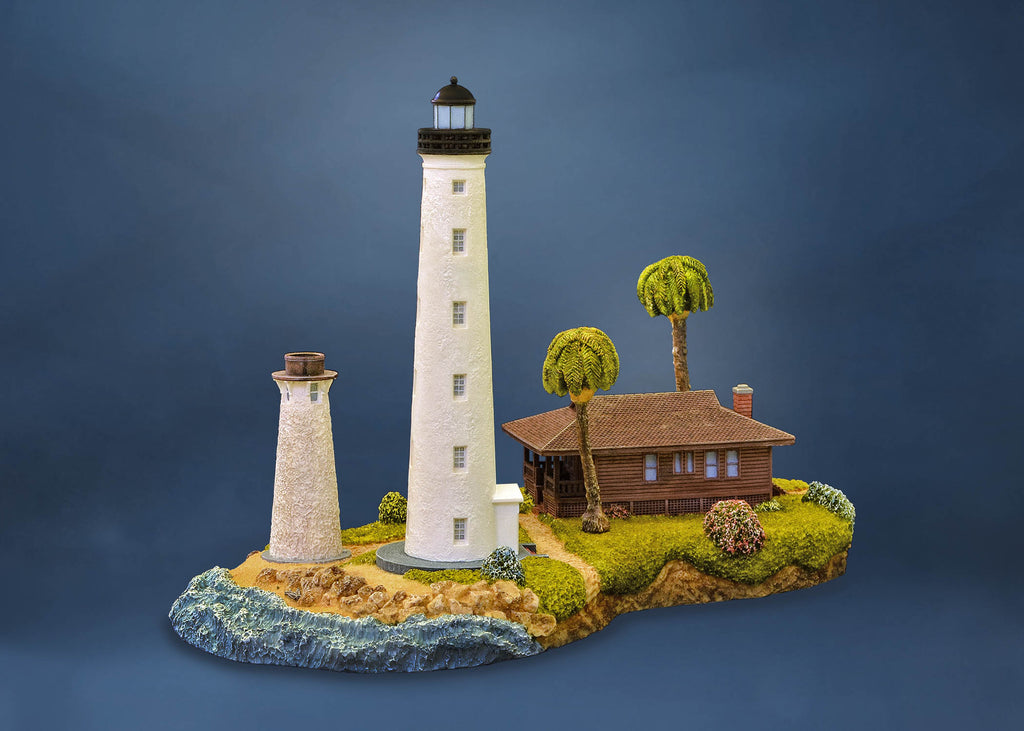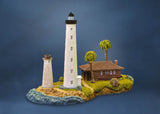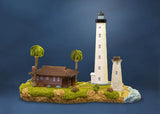It's been a long time in development, but at long last the Barbers Point Lighthouse sculpture is here.
Each piece has been cast and painted by myself, in my studio, here in San Diego. I've also gone to great lengths to source US made materials. From casting and mold making materials, paints, to the final packaging. This piece is 100% US made of 95% US made materials.
The production process does take quite a long time so there is a possibility this piece may be out of stock from time to time. Don't worry, I'll be making more. If I'm out of stock send me a message that you would like to add this piece to your collection through the CONTACT tab at the top of the page and I'll reserve a piece for you in the next batch.
-------------
History of Barbers Point
On October 31, 1796, the brig Arthur, captained by Henry Barber, was sailing west from Honolulu to Canton with a load of sea otter pelts aboard, shortly after leaving Honolulu, it struck a coral reef that extends from the southwest tip of the island of Oahu. Six of the crew of twenty-two along with the ship were lost in the wreck. Since the grounding, the point has been associated with Captain Baber of the ill-fated vessel. In 1968, the U.S. Board of Geographic Names dropped the apostrophe, changing the name from Barber's Point to Barbers Point.
A sum of $2,500 was appropriated in 1880 for the construction of a light at the point, and soon thereafter the French company of L. Sautter-Lemonnier was contracted to supply a fourth-order Fresnel lens along with the lamps and lantern room for the proposed tower. By the time the lighthouse hardware arrived from France, the lighthouse funds were depleted, and the shipment was placed in storage.
Six years passed before $3,000 was provided to construct the tower on land donated by James Campbell. Peter High submitted the lowest of the six bids received for the project in early February 1888, and he was awarded a contract to construct a stone lighthouse for $1,892 and a keeper’s dwelling for $309. During the first part of 1888, a forty-two-foot tower was constructed of coral stone laid in a cement mortar, and a frame dwelling was built. Upon completion, the tower was painted white and topped with the red lantern room. The light was exhibited for the first time on March 29, 1888, and William Hatton Aalona was hired as its keeper at an annual salary of $240.
Early in the morning of August 31, 1906, the army transport ship Sheridan ran aground on Barbers Point. Keeper Hatton Aalona was relieved when the transport officers admitted his light was burning. “That light never go out one time since I became keeper here nearly twenty years ago,” Aalona said. “I feel very sorry about the transport, but the light was there all right.” When Keeper Aalona saw the transport run aground, he awakened the “wireless telegraph boy,” who was able to pass the news along to Honolulu.
After having been in charge of the light for nearly twenty years, Keeper Aalona, who was considered to be in good health though he was in his seventies, died in his sleep on February 14, 1907. Local papers publicized the death of Keeper Aalona and noted that he had served as a whaler and captain of inter-island vessels before becoming a lighthouse keeper and that he had become a Mormon convert when George Q. Cannon visited the Hawaiian Islands in the early 1850s.
To make its light more readily distinguishable from the steady plantation lights in the vicinity, the lighthouse was remodeled in 1912 to accommodate a fourth-order, double-flash lens illuminated by an incandescent oil vapor lamp. The new lens revolved once every five seconds to produce two 0.1-second flashes separated by 1.1 seconds and followed by a 3.7-second eclipse.
An assistant keeper was assigned to Barbers Point to help with the extra work required by the new illuminating apparatus, and a two-room structure was built to provide temporary housing. A proper second dwelling, built atop concrete piers and equipped with indoor plumbing, was added to the station in 1915 at a cost of $3,199.
By 1930, the tower was showing signs of deterioration and plans were made to replace the structure. An appropriation of $20,000 was secured in 1933 for erecting a seventy-two-foot, reinforced-concrete, cylindrical tower next to the original one. At the same time, generators were installed at the station to supply electricity to both the lighthouse and the keeper’s dwellings. The lens was transferred from the old tower to the new one, where it was first lit on December 29, 1933 500-watt bulb. With a crowd of interested spectators looking on, cuts were made in the coral stone on one side of the old tower, causing it to topple over.
Keeper John M. Sweeney observed the Japanese attack on Pearl Harbour on December 7, 1941 and a few days later wrote the following letter describing events at the station.
At 8:00 a.m. many planes were seen overhead, both Japanese and ours. Dog fighting continued for twenty minutes, bullets hitting the ground in bursts. Then all planes headed south, our planes chasing them. Seemed to have come from the windward side, and left the Island on Barbers Point side.
Two parachutists were dropped close to the station; they were confused in the kiawi trees and prowled around the station all Sunday night, the Fort Kam. 55th C.A. boys firing at them with rifles and machine guns. One was wounded, and was later found on the beach, buried by his mate. His feet were sticking out of the sand. The other was later shot by an officer.
Monday night was bad; the boys were nervous and had to go with them to the top of the tower two times. First they thought a green light was on top of the tower. It proved to be the reflection of the moon on the glass. The next time they thought parachutists were on top of the tower. It proved to be nothing. They escorted me to the house and warned me not to go outside as they would shoot at anything.
When we got the word that the two Japs were located, we felt easy, and Tuesday night was the first night anybody slept.
On April 15, 1964, a thirty-six-inch airway beacon replaced the station’s Fresnel lens, and Fred Robins, the last keeper, left the automated lighthouse later that year on December 7.
The lantern room was likely removed from the Barbers Point Lighthouse when it was automated. In 1985, the airway beacon was replaced by a Double Barreled Rotating Optic Directional Code Beacon (DCB-224), which increased the range of the light to twenty-four nautical miles.
This article was provided by: http://www.lighthousefriends.com




